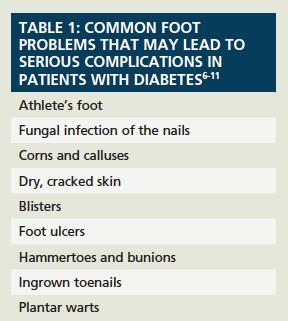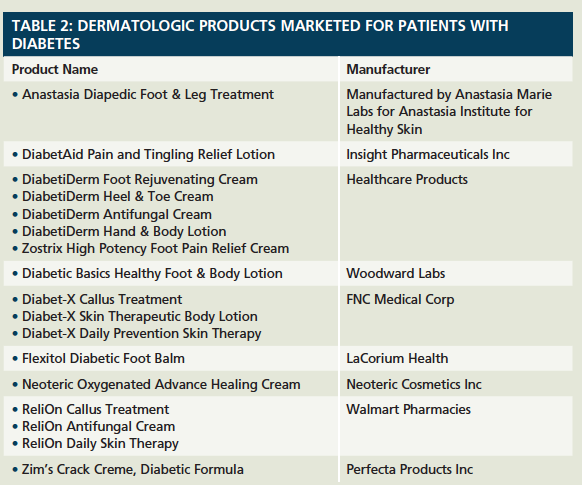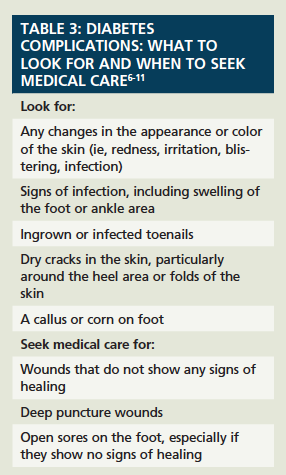Publication
Article
Pharmacy Times
Diabetic Foot Care: The Importance of Adherence
Author(s):
Maintaining tight glycemic control and performing proper foot care are critical to decreasing the incidence of foot ulcers and possible amputations among patients with diabetes.1,2
Although the number of newly diagnosed cases of diabetes in the United States continues to escalate annually, there is good news. According to the Centers for Disease Control and Prevention (CDC), there has been a significant decline in the number of lower limb amputations among adults with diabetes due to early intervention, timely management, and increased patient education efforts.1-3
Goals of Diabetic Foot Care
When counseling patients with diabetes about their medications, pharmacists should seize the opportunity to make them aware of and educate them about the importance of diabetic foot care in reducing or preventing potential complications. The main goals of diabetic foot care involve a combination of preventive strategies, including patient education, involvement, and adherence to physician recommendations, as well as maintaining tight glycemic control and performing routine skin, foot, and nail inspections.3-5
Left untreated, bacterial and fungal infections, as well as foot ulcers, can lead to amputation.1,2 Certain foot-related complications, such as skin changes (dryness, itching) and foot ulcers, are common among patients with diabetes (Table 1)6-11; many of these conditions are attributed to vascular disease, neuropathy, and relative immunosuppression. 5 Patients with diabetes, especially those whose disease is poorly controlled, are more susceptible to skin-related complications. Therefore, patients should be reminded that many dermatologic conditions can be prevented or effectively treated if identified early through daily skin inspections and proper foot care.

Foot Care Standards
Statistics from the CDC and the National Institutes of Health Diabetes Information Clearinghouse indicate that comprehensive foot care programs, such as foot care education, risk assessment, and preventive therapy, may decrease amputation rates by 45% to 85%.9 In addition, the American Diabetes Association’s Standards of Medical Care, released in 2014, include the following foot care recommendations12:
- Patients with diabetes should obtain an annual comprehensive foot examination to identify risk factors predictive of ulcers and amputations.
- Patients with diabetes should receive general foot self-care education from their primary health care provider.
- A multidisciplinary approach is recommended for patients with foot ulcers and those at high risk for foot complications, especially individuals with a history of prior ulcer or amputation.
- Patients who smoke and/or have structural abnormalities, as well as those with a history of lower extremity complications, should be referred to foot care specialists for ongoing preventive care and lifelong surveillance.
Nonprescription Products

Many nonprescription dermatologic products are formulated to address the specific skin care needs of patients with diabetes, including antimicrobial lotions, moisturizers, antifungals, and callus treatments (Table 2). While assisting patients in the selection of skin care products, pharmacists can also reinforce the significance of routine foot care and inspections as well as provide key information regarding diabetic foot care.5-8 During counseling, patients should be encouraged to seek immediate medical care when warranted to avoid further complications (Table 3).6-11 Likewise, patients should be encouraged to discuss the various possible diabetes-associated skin-related complications with their primary health care provider to learn how to recognize and manage these conditions.


Patients with diabetes can take a proactive role in reducing and preventing dermatologic issues by incorporating diabetic foot care into their daily routine (Table 4).6-10 Numerous educational resources regarding diabetic foot care are available (Online Table 5). Encouraging patients to effectively manage their diabetes by adhering to therapeutic recommendations and monitoring parameters not only prevents complications but also enables patients to improve their overall quality of life—and put their best foot forward.
TABLE 5: EDUCATIONAL RESOURCES REGARDING DIABETIC FOOT CARE
- Take Care of Your Feet for a Lifetime: www.ndep.nih.gov/publications/PublicationDetail.aspx?PubId=67
- Stop Diabetes from Knocking You Off Your Feet: www.stopdiabetes.com/whats-happening/news-stories/stop-diabetes-from-knocking-you-off-your-feet.html
Ms. Terrie is a clinical pharmacy writer based in Haymarket, Virginia.
References
1. CDC data show decline in 5 major diabetes-related complications among US adults. CDC website. www.cdc.gov/diabetes/news/docs/cdcstudy.htm. Accessed September 22, 2014.
2. Belatti DA, Phisitkul P. Declines in lower extremity amputation in the US Medicare population, 2000-2010. Foot Ankle Int. 2013;34(7):923-931.
3. CDC report finds large decline in lower-limb amputations among U.S. adults with diagnosed diabetes [press release]. Atlanta, GA: Centers for Disease Control and Prevention; January 24, 2012. www.cdc.gov/media/releases/2012/p0124_lower_limb.html. Accessed September 22, 2014.
4. Living with diabetes: skin complications. American Diabetes Association website. www.diabetes.org/living-with-diabetes/complications/skin-complications.html. Updated March 31, 2014. Accessed September 22, 2014.
5. Living with diabetes: skin care. American Diabetes Association website. www.diabetes.org/living-with-diabetes/complications/skin-care.html. Updated December 10, 2013. Accessed September 22, 2014.
6. American Diabetes Association. Preventive foot care in diabetes: position statement. Diabetes Care. 2004;27(suppl 1):S63-S64. care.diabetesjournals.org/content/27/suppl_1/s63.full.pdf. Accessed September 22, 2014.
7. Diabetic complications and amputation prevention. American College of Foot and Ankle Surgeons website. www.footphysicians.com/footankleinfo/diabetic-amputations.htm. Accessed September 22, 2014.
8. Diabetes: foot care. www.nlm.nih.gov/medlineplus/tutorials/diabetesfootcare/db029105.pdf. Coralville, IA: Patient Education Institute. Updated January 23, 2014. Accessed September 22, 2014.
9. Foot and skin related complications of diabetes. Cleveland Clinic website. http://my.clevelandclinic.org/disorders/diabetes_mellitus/hic_foot_and_skin_related_complications_of_diabetes.aspx. Updated March 15, 2010. Accessed September 22, 2014.
10. National Diabetes Fact Sheet 2011. CDC website. www.cdc.gov/diabetes/pubs/pdf/ndfs_2011.pdf. Accessed September 22, 2014.
11. Foot care. American Diabetes Association website. www.diabetes.org/living-with-diabetes/complications/foot-complications/foot-care.html. Updated March 11, 2014. Accessed September 22, 2014.
12. American Diabetes Association. Standards of medical care in diabetes—2014. Diabetes Care. 2014;37(suppl 1):S14-S80. http://care.diabetesjournals.org/content/37/Supplement_1/S14.full.pdf+html. Accessed September 22, 2014.
13. Assemi M, Morello C. Diabetes mellitus. In: Krinsky D. Berardi R, Ferreri S, et al, eds. Handbook of Nonprescription Drugs. 17th ed. Washington, DC: American Pharmacists Association; 2012.

Newsletter
Stay informed on drug updates, treatment guidelines, and pharmacy practice trends—subscribe to Pharmacy Times for weekly clinical insights.






